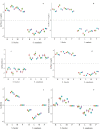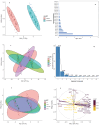Evaluating Sorghum bicolor resistance to Solidago canadensis invasion under different nitrogen scenarios
- PMID: 39534106
- PMCID: PMC11555567
- DOI: 10.3389/fpls.2024.1468816
Evaluating Sorghum bicolor resistance to Solidago canadensis invasion under different nitrogen scenarios
Abstract
Ecosystem exposure to a biological invasion such as plant invasion could contribute to the extinction of native species and loss of productivity and ecosystem balance. Solidago canadensis (S. canadensis) is a highly invasive species that has formed monocultures in China, Europe, Asia, Australia, and New Zealand. It was designated as a notorious invasive species by the Chinese government. It has adversely affected the agroecosystem's ability to germinate various plant seeds, including wheat, lettuce, and pepper, which could lead to food insecurity. This study was conducted to control the invasive species S. canadensis by utilizing a competitive species, Sorghum bicolor (S. bicolor) as a cover plant. Sorghum bicolor exudes allelochemicals such as sorgoleone from its roots which suppress the photosystem II activity of nearby plants. The synthesis of sorgoleone depends on a supply of nitrogen. The present study involved the cultivation of S. bicolor alongside the invasive species S. canadensis, with three different invasion levels (high, medium, and low) and three different nitrogen forms (ammonical, nitrate, and combined ammonical and nitrate nitrogen) applied as a modified Hogland solution. S. bicolor expressed higher performance over the invasive species under ammonical and combined nitrogen forms under low and medium invasion levels. Furthermore, even at greater levels of invasion, S. bicolor was not suppressed by S. canadensis. However, the plant height and dry biomass of S. bicolor were significantly high across both nitrogen forms. Leaf area, CO2 uptake, and photosystem II activity of S. canadensis were unable to sustain its growth under the low invasion condition. The plant biomass of S. canadensis was suppressed by up to 80% and the relative dominance index of S. bicolor was 5.22 over S. canadensis. There was a strong correlation between CO2 uptake, leaf area, and plant biomass. Principal component analysis showed that the first four components had a total variance of 96.89%, with principal component 1 (PC1) having the highest eigenvalue at 18.65. These promising findings suggested that S. bicolor, whose high intensity might be employed to control the invasion process for environmental safety, might be able to recover the barren ground that S. canadensis had invaded.
Keywords: S. bicolor; S. canadensis; ecosystem; invasion; nitrogen.
Copyright © 2024 Anas, Khan, Alomrani, Nawaz, Huang, Alshehri, Al-Ghanim, Qi, Li, Dai, Ali and Du.
Conflict of interest statement
The authors declare that the research was conducted in the absence of any commercial or financial relationships that could be construed as a potential conflict of interest.
Figures






Similar articles
-
Persistence of Root Exudates of Sorghum bicolor and Solidago canadensis: Impacts on Invasive and Native Species.Plants (Basel). 2023 Dec 23;13(1):58. doi: 10.3390/plants13010058. Plants (Basel). 2023. PMID: 38202366 Free PMC article.
-
Additive effects of warming and nitrogen addition on the performance and competitiveness of invasive Solidago canadensis L.Front Plant Sci. 2022 Nov 3;13:1017554. doi: 10.3389/fpls.2022.1017554. eCollection 2022. Front Plant Sci. 2022. PMID: 36407577 Free PMC article.
-
Erigeron annuus (L.) Pers. and Solidago canadensis L. antagonistically affect community stability and community invasibility under the co-invasion condition.Sci Total Environ. 2020 May 10;716:137128. doi: 10.1016/j.scitotenv.2020.137128. Epub 2020 Feb 5. Sci Total Environ. 2020. PMID: 32045766
-
Selected Aspects of Invasive Solidago canadensis with an Emphasis on Its Allelopathic Abilities: A Review.Chem Biodivers. 2022 Oct;19(10):e202200728. doi: 10.1002/cbdv.202200728. Epub 2022 Sep 23. Chem Biodivers. 2022. PMID: 36056470 Review.
-
Allelopathy and Allelochemicals of Solidago canadensis L. and S. altissima L. for Their Naturalization.Plants (Basel). 2022 Nov 25;11(23):3235. doi: 10.3390/plants11233235. Plants (Basel). 2022. PMID: 36501274 Free PMC article. Review.
Cited by
-
Interactive Effect of Microplastics and Fungal Pathogen Rhizoctonia solani on Antioxidative Mechanism and Fluorescence Activity of Invasive Species Solidago canadensis.Plants (Basel). 2025 Jun 27;14(13):1972. doi: 10.3390/plants14131972. Plants (Basel). 2025. PMID: 40647980 Free PMC article.
References
-
- Afzal M. R., Zhang M., Jin H., Wang G., Zhang M., Ding M., et al. . (2020). Post-translational regulation of plasma membrane H+-ATPase is involved in the release of biological nitrification inhibitors from sorghum roots. Plant Soil 450, 357–372. doi: 10.1007/s11104-020-04511-6 - DOI
-
- Amanullah A., Stewart B. A. (2013). Shoot: root differs in warm season C4-cereals when grown alone in pure and mixed stands under low and high water levels. Pak. J. Bot. 45, 83–90. Available at: http://www.pakbs.org/pjbot/PDFs/45(S1)/12.pdf (Accessed June 28, 2024)
-
- Anas M., Jabbar A., Sarwar M. A., Ullah R., Abuzar M. K., Ijaz A., et al. . (2017). Intercropping sunflower with mungbean for improved productivity and net economic return under irrigated conditions. Pak. J. Agr. Res. 30, 338–345. doi: 10.17582/journal.pjar/2017/30.4.338.345 - DOI
LinkOut - more resources
Full Text Sources
Research Materials
Miscellaneous

